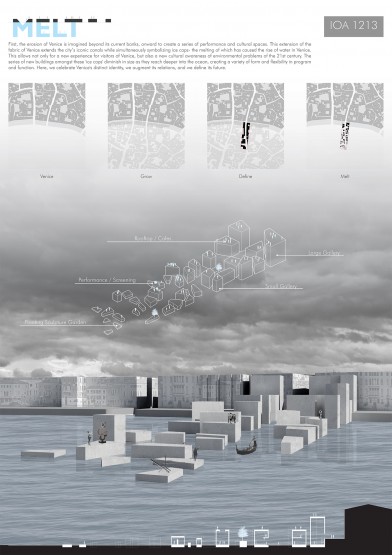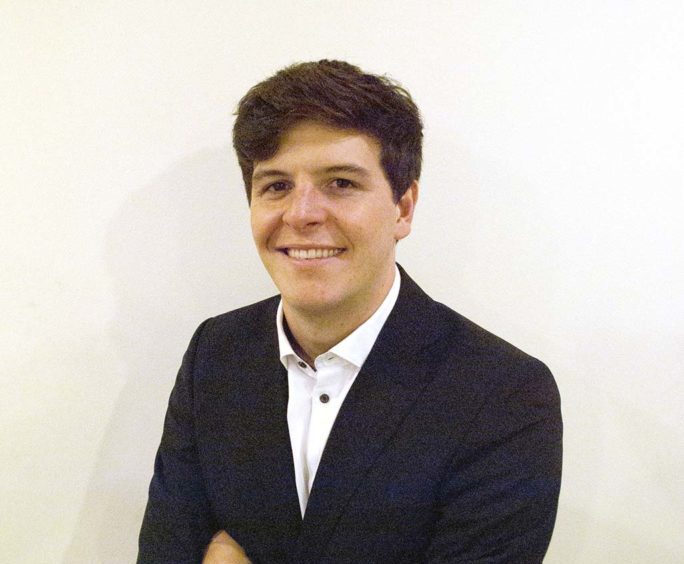Name: Felipe Tejeda
Graduation Year: B.S. Architecture 2015
Hometown: Santiago, Chile
Recent graduate Felipe Tejeda just placed 3rd in the Arquideas International Competition, Island of Arts-Venice.

The objective of the competition was to imagine a space that can support different activities linked to art and culture that would be able to be incorporated into the fabric of Venice, a historic city with many contemporary challenges. Felipe used the metaphor of melting ice caps to both address the rising sea levels that are having a perilous effect on Venice and as a design motif to frame his concept. You can see the full project here.
We recently got hear from Felipe about this project and life beyond Ruggles Studio.
Why did you enter the Arquideas competition?
After graduating from architecture school, you expect to be working in a very creative environment. At times, you must adapt to the client’s needs, budgets, and the more technical aspects of architecture. I entered this competition in order to maintain the creative momentum that I developed while studying at Northeastern. It was an opportunity to have total creative control over my own ideas and designs.
How do you think placing in the top 3 of an international competition will influence you?
Placing in the top 3 has definitely given me the confidence to pursue opportunities where I can exercise my own design sensibility. As an entry level architect, I don’t get many chances to prove my skills as a designer. Thanks to the competition, I was able to get exposure, and more importantly, recognition. This has given me the drive to think about ways I can use design to solve major challenges that cities area currently facing. I plan to engage more on this theme, whether through more competitions or through personal projects.
Was there an experience here at NU that helped prepare you for producing work for this competition
I owe a lot of credit to my professors at NU, whom I found to be very influential in my development as an architect. While designing for this competition, I would remember some of the lessons they taught me about the process and it would make me rethink my entire idea. The RISE Expo was another experience that prepared me. The steps I went through when I participated in that campus-wide event helped in preparing my pitch and selling my idea for the Island of Arts-Venice project
Where are you working now?
Until recently, I was working at Arquitectonica NY. The competition experience has motivated me to explore more creative opportunities. Although I am looking for something different, Arquitectonica exposed me to a variety of different industries and I have learned a lot about hospitality design.
How did your educational experience prepare you for work in the profession?
Nothing prepares you for work in the profession like co-op does. It allows you to demonstrate your unique skills and experiences to employers before you have the pressure of a full-time, long-term position.
How is this different than being on coop?
As a permanent employee, rather than an intern, I have been given much more responsibility as well as more opportunities to prove myself. I feel that because I had co-op experience, co-workers trust me with more responsibility and more complex tasks. There were still many occasions where I faced new challenges and had to do things I had not done before, which shows that just like in co-op, you never stop learning new things.
What is it about Architecture that drives you?
I truly believe that creative design offers a unique opportunity when tackling any challenge or problem. Architecture in particular, has an important role in addressing many of our contemporary societal problems. It is this opportunity that I want to be involved in as a designer. I want to be a part of the next generation of architects that will prioritize making our cities a better place.
What are some the most interesting projects that you have had the opportunity to work on?
I was lucky enough to work on a team that was designing an expansion of the Seattle Aquarium. This was a very unique and interesting opportunity due to the nature of the site. The project that I have been most engaged with has been a 300-room hotel. Negotiating the complex relationship between the public and service areas made working on this project both challenging and interesting.
What is something you wish someone had told you when you were first starting out in school?
I wish someone would have emphasized that a job interview can and should be a two-way process. As a candidate, I felt a lot of pressure to impress the interviewer. It is easy to forget to focus on what the experience has to offer a young architect in terms of engagement and professional development. It is to the benefit of both parties to ensure that the applicant gets the right job in the right place.


